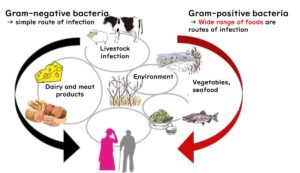Listeria monocytogenes
Discover detailed insights into Listeria monocytogenes, a critical pathogen in ready-to-eat foods and chilled products. Understand its growth conditions, risk factors, detection methods, and effective control measures to maintain food safety and prevent listeriosis outbreaks.
Controlling Listeria monocytogenes in Ready-to-Eat Foods with Nisin and Organic Acids
Listeria monocytogenes is a notorious risk in food processing facilities, particularly known for forming biofilms that make it hard to eliminate entirely from ready-to-eat (RTE) products. A promising solution gaining attention in the US is the combined use of nisin and organic acids during distribution. This article delves into how this method helps control Listeria monocytogenes in RTE foods, enhancing their safety.
Listeriolysin O (LLO) in Listeria monocytogenes: Defence Against Protozoa in Animal Gut and Soil?
When Listeria monocytogenes infect humans, they invade the epithelial cells of the intestines and cleverly evade immune responses, such as macrophage predation, by parasitizing inside cells. This cunning infection mechanism leads to Listeria infections, which are particularly dangerous for pregnant women, causing miscarriages, and for the elderly, resulting in severe conditions like sepsis and meningitis. A critical factor in Listeria infection is Listeriolysin O (LLO). This article introduces research by Dr. Pushkareva and colleagues from the Russian Academy of Medical Sciences, which suggests that Listeriolysin O originally evolved in the natural ecosystem as part of a predator-prey relationship with the ciliate Tetrahymena.
Listeria monocytogenes: Risks, Regulations, and Effective Control in Ready-to-Eat Foods
This article explores Listeria monocytogenes, a resilient Gram-positive bacterium responsible for severe foodborne illness, particularly affecting pregnant women, the elderly, and those with weakened immune systems. Learn why this pathogen is a critical concern in ready-to-eat foods such as deli meats, cheeses, and smoked seafood. We delve into its unique survival abilities, its high fatality rate in outbreaks, and the regulatory differences across the U.S., EU, and Japan. Discover best practices and strategies to control this persistent threat in food production and safeguard public health.


